Lead and Copper Rule
On December 16, 2021, the United States Environmental Protection Agency (EPA) published the Lead and Copper Rule Revisions (LCRR) in the Federal Register to protect public health by reducing lead levels in drinking water. In response to these updated federal regulations, the City of Independence Water Department is working to complete a comprehensive Lead and Copper Inventory Program. The recent updates to the Safe Drinking Water Act have made it imperative for cities to take action in identifying, mapping, and mitigating the potential risks associated with lead materials used in our water system.
To fulfill new federal requirements, the City of Independence is asking residents to complete an in-home service line inspection. Check internal household plumbing using the Identifying Service Line Materials Guide below. Determine the service line material and fill out the Water Service Line Inventory Self Identification Form included in the link below. Provide the form by e-mailing a copy of the form to: slidentify@indepmo.org mail or mailing/delivering it to our Utility Customer Service at:
Independence Utilities Center
Water Service Line Inventory
17221 E. 23rd St
Independence, MO 64057
Water Service Line Inventory Self Identification Form
Identifying Service Line Material Guide
Service lines are the pipes that connect a building's plumbing to a public drinking water system, carrying water from the water main to the home or building. Even though the federal government banned using leaded pipe and solder in new plumbing systems built after 1986, lead pipes can still be found in older facilities. The lead ban for Missouri became effective Jan. 1, 1989.
The service line to your building or home could be made of plastic, copper, galvanized steel, lead or a combination of materials. To determine what your service line is made of, grab a magnet and a key or coin, and follow the steps below. If you cannot locate your water meter or service line, or it is unclear which category applies to the pipe, please call the Independence Water Department at 816-325-7664 to schedule a time for one of our service workers to assist you.
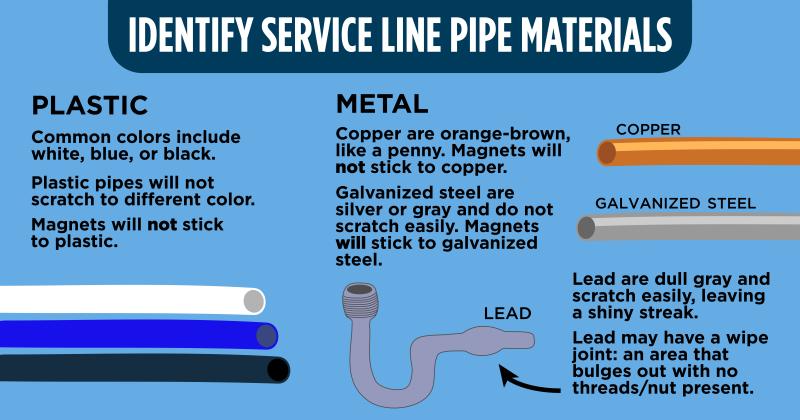
Buildings or homes on public water systems have a water meter, which could be located either inside or outside of the structure. The actual water meter will have a dial or digital display that reads "cubic feet" and will look similar to the picture above. If it is much larger, located above ground outside of your home it will most likely be either your gas or electric meter.
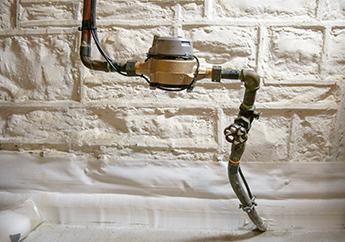
Find the Service Line
- If the water meter is located inside, the service line will enter the building or home a few feet underground before coming through the outside wall or foundation and connecting to the water meter (Fig. 1).
-
If the water meter is located outside, you will want to take the shortest path from the water meter to the building or home. This is typically where the service line enters the structure. You may also notice a small black or gray box on the side of your house. This will be a remote touch pad that our meter readers use to read your meter every month. Note this location and then go inside and try to locate the service line.
The service line should be a ¾”, (0.75 inch) to 1-inch pipe coming from either underground or through the foundation floor or wall, with an attached shutoff valve that looks something similar to the (Fig. 1) photo with the water meter. Keep in mind that each installation is unique and will vary from the photo provided. Focus on the section of pipe where the service line enters the building. Is that section of pipe made of plastic or metal?
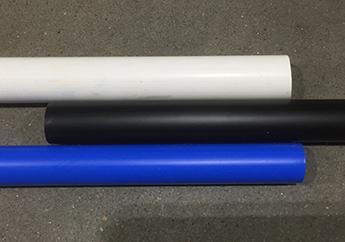
Plastic Pipe
If the pipe is plastic, it indicates that your service line will most likely not be constructed of lead. Plastic pipes may be many colors: white, blue or black are common (Fig. 2). Most people are familiar with plastic and can easily identify it.
Metal Pipe
Most homes and businesses in Independence will have a metal service line that enters the home. If the pipe is metal, it could be copper, galvanized steel or lead. You can narrow down which metal your service line is with a few simple tests.
What Color is the Pipe?
Using the key or coin, scratch the metal pipe close to where it enters the house through the wall. What color is the pipe?
- Orange-brown, like a shiny penny: The pipe is most likely made of copper (Fig. 3)
- Silver or Gray: The pipe could be galvanized steel (Fig. 4) or lead (Fig. 1)
Copper Pipe
Copper pipe is orange-brown and shiny like a new penny when scratched with a coin, nail or key. Old copper may be weathered and may have a green tint, or it may be painted. This is why you may need to scratch the copper pipe to be sure.
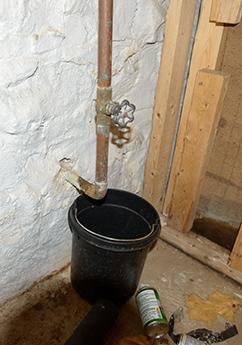
Is the Silver or Gray Pipe Magnetic?
If it is not orange-brown in color and instead a silver or gray you will have to do an additional test. On the same section of pipe, touch the magnet to the metal pipe. Does the magnet stick?
- Yes: The pipe is most likely galvanized steel. A thick coat of paint and a weak magnet may prevent the magnet from sticking. If you scratched the paint off of the pipe in an area, be sure and try the magnet test directly on that spot.
- No: The pipe could be made of lead.
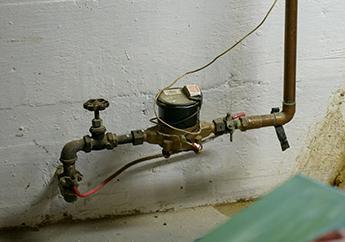
Galvanized Steel Pipe
Galvanized pipe silver or gray and has threaded fittings (Fig 4). If you see pipe threads with a six-sided nut in places where there is a connection, it is most likely galvanized. A magnet will usually stick to a galvanized steel pipe. When scratched with a coin or key it will feel very rigid and not become shiny.
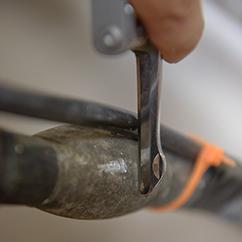
Lead Pipe
If the pipe is silver/gray and not magnetic, was it hard or soft when you scratched it?
-
If it was hard or rigid, the pipe could be galvanized
-
If it was soft and the pipe became shiny when scratched, the pipe is more likely made of lead
History of Lead and Copper Rule
The Lead and Copper Rule (LCR) is the National Primary Drinking Water Regulation first promulgated in 1991 that requires actions by public water systems to reduce levels of lead and copper in drinking water.. On January 15, 2021, the EPA promulgated the Lead and Copper Rule Revisions (LCRR), and the deadline for water systems to comply with these revised requirements is October 16, 2024. On December 6, 2023, EPA published the proposed Lead and Copper Rule Improvements (LCRI) that, when final, will significantly reduce exposure to lead through drinking water.
EPA’s new Lead and Copper Rule better protects children and communities from the risks of lead exposure by better protecting children at schools and child care facilities, getting the lead out of our nation’s drinking water, and empowering communities through information. Improvements under the new rule include:
- Using science-based testing protocols to find more sources of lead in drinking water.
- Establishing a trigger level to jumpstart mitigation earlier and in more communities.
- Driving more and complete lead service line replacements.
- For the first time, requiring testing in schools and child care facilities.
- Requiring water systems to identify and make public the locations of lead service lines
Health Effects of Lead Consumption
Exposure to lead in drinking water can cause serious health effects in all age groups. Infants and children can have decreases in IQ and attention span. Lead exposure can lead to new learning and behavior problems or exacerbate existing learning and behavior problems. The children of women who are exposed to lead before or during pregnancy can have increased risk of these adverse health effects. Adults can have increased risks of heart disease, high blood pressure, kidney, or nervous system problems.
Lead in drinking water, although rarely a sole cause of lead poisoning, can significantly increase a person’s total lead exposure. Infants who drink baby formulas and concentrates that are mixed with water containing lead are particularly at risk. EPA estimates that drinking water can make up 20% or more of a person’s total exposure to lead. Boiling water does not reduce lead levels.
Please see the following link for additional information concerning the health effects of lead. https://dnr.mo.gov/document-search/lead-drinking-water-important-inform…
How to Reduce Lead in Drinking Water
Information on lead in drinking water, testing methods and steps you can take to minimize exposure is available at http://www.epa.gov/safewater/lead.
1. Run your water to flush out lead. If a faucet has not been used for several hours, allow the water to run at the tap for 15 to 30 seconds or until it becomes cold and reaches a steady temperature before using it for drinking or cooking. This flushes lead-containing water from the pipes. The water you run from drinking water taps does not have to be wasted; you can use this water for cleaning purposes or watering plants. You may want to keep a container of drinking water in your refrigerator, so you don’t have to run water every time you need it.
2. Use cold water for cooking and preparing baby formula. Do not drink or cook with water from the hot water tap, as lead dissolves more easily into hot water. Do not use water from the hot water tap to make baby formula.
3. Do not boil water to remove lead. Boiling water will not reduce the lead content.
4. Look for alternative sources or treatment of water. If water testing has shown you have elevated lead in your drinking water, you may want to consider purchasing bottled water or a water filter. Read the package to be sure the filter is approved to reduce lead, with NSF/ANSI 53-2021 labeling, or contact the National Sanitation Foundation at 800-NSF-8010 (800-673-8010) for information on performance standards for water filters. If you choose to install a lead-removal filter, be sure to maintain and replace the filter device according to the manufacturer’s instructions to protect water quality.
Lead and Copper Rule FAQs
EPA is a Federal agency put in place to protect health and the environment. They develop, monitor and enforce regulations relating to public health and the environment.
The lead and copper rule was put in place by the EPA in 1992 to ensure that water consumers are not exposed to excessive amounts of lead or copper that can leach into the water from the distribution pipes if the water quality is not maintained properly.
The City tests the water supply annually for lead and copper and has maintained compliance with the rule's guidelines since its inception in 1992.
No. The letter states that a potential source of lead could come from the customer’s service line that connects your home to the City’s water main in the street depending on what material your service line is constructed with.
No. The water source, treatment technique and quality of water in Independence has remained consistent for almost 70 years. Independence treats its water to ensure that it is not corrosive so that it does not leach metals from the surrounding pipes. By doing this, we lessen the possibility of lead contamination from any potential lead sources in the system or premise plumbing.
The water service line supplying your home/building was classified as either "Galvanized Requiring Replacement" or "Unknown, Possible Lead".
Due to a recent update to the regulation, implemented on October 8, 2024, all water utilities in the US are now required to inventory the materials of every service line in their systems. If you have a service line constructed of "Lead", "Galvanized Requiring Replacement", or "Unknown, Possible Lead", the utilities are required to notify you in writing and provide you this notice on the health impacts of lead.
No, only those customers with a service line classified as "Galvanized Requiring Replacement" or "Unknown, Possible Lead". If you did not receive one of these letters this means your service line was constructed of a material that has no potential lead source such as copper or plastic.
Galvanized lines by themselves do not pose an increased risk of lead. If we have a record showing that your entire service line has always been constructed of galvanized, it will be classified as Galvanized. However, if your service line is galvanized and we do not have a record to prove that your service line was never lead we must classify your service line as galvanized requiring replacement.
If we do not have a record of what your service line material was originally constructed of and have since verified that it contains galvanized pipe, we cannot rule out that a portion of the service line could have been constructed with lead pipe. For that reason, we must err on the side of caution and classify it as "Galvanized Requiring Replacement".
Water utilities with service lines in their systems containing lead or galvanized requiring replacement service lines must develop a service line replacement program with the goal of having all service lines in these two categories replaced by November 1, 2037.
The entire water service line is owned by the water customer in Independence. Since the City does not own the service lines we are not required to fund the replacement of your line. However, the City is actively seeking funding opportunities available through grant programs from the federal government and other sources. The City is currently developing a plan to apply for these grants and a fair way to administer those grant funds to aid customers with these types of service lines to get them replaced.
The cost will vary for each customer. This will depend on how long your service line is, access to your basement/crawlspace, obstructions encountered in your yard and a host of other items.
The City is currently developing a plan to meet the requirements of this regulation, including a service line replacement plan. We are currently reviewing several options and hope to have a plan completed soon.
The entire water service line is owned and maintained by the property owner. The City cannot require you to replace your line, it is your choice.
If your services line was classified as “Unknown, Possible Lead” and you have personal knowledge of the material your service line is constructed of OR if your service line was classified as “Galvanized Requiring Replacement” and you have personal knowledge that it is not constructed of galvanized pipe please complete the Self Identification Form included with the health notice and return it to the Independence Utilities Center located at 17221 E. 23rd St., Independence, MO.
Independence has been testing water annually for lead and copper since the inception of the original Lead and Copper Rule in 1992. Since that time we have remained in compliance with the rule and never exceeded the allowable limits of either lead or copper.
It is not uncommon for the water customers to own and maintain at least some portion of their service lines. It has been a long standing rule of the Independence Water Utility that the customer owns the entire service line and is responsible to maintain it.
Yes. As stated in the notice, if you are unsure how to identify the materials of your service line and would like assistance please contact us at 816-325-7664 to make an appointment with our water field services to provide this service.
No.
No.
The City is not aware of any lead service lines in Independence but we do not have a record on every service line in the City. Until we have identified the material of each service line, we can’t rule out the possibility.
